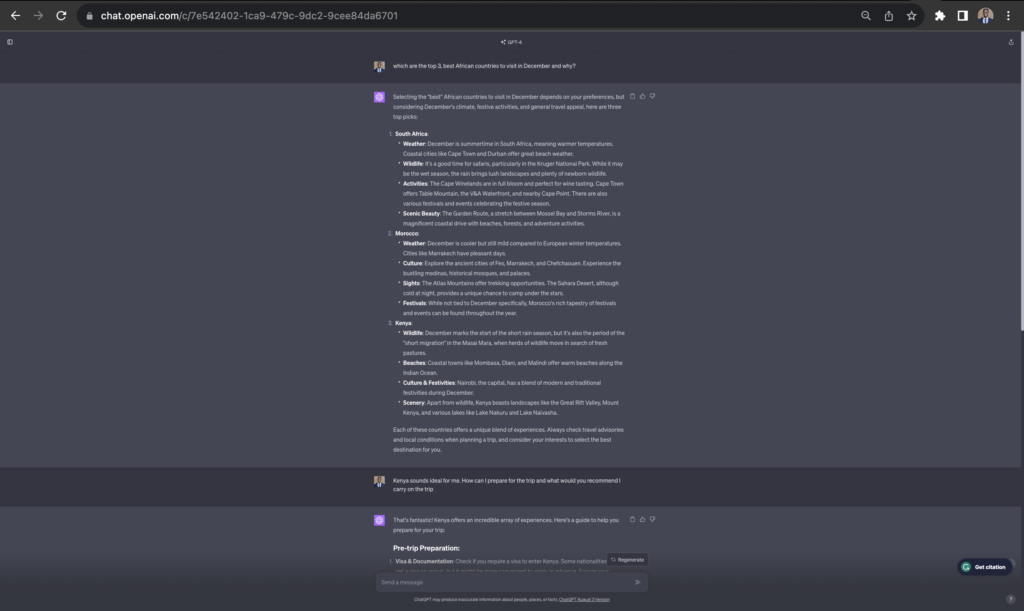
When it comes to artificial intelligence (AI), few innovations have captured the world’s attention as swiftly as ChatGPT. Developed by San Francisco-based AI powerhouse OpenAI, ChatGPT has become a sensation, reaching a staggering 100 million users within just two months of its launch. The fastest ever user adoption rate, even surpassing that of Facebook and Tiktok. But what exactly is ChatGPT, and why has it garnered such immense popularity? Let’s delve into the world of this revolutionary AI chatbot.
What is ChatGPT?
ChatGPT is an AI chatbot with natural language processing (NLP) capabilities, meaning it is able to understand and hold human-like conversations. ChatGPT can answer questions and assist with tasks of varying complexity, from simple tasks like composing emails and poems, to more complex ones like writing code and analysing data.
The images below are screenshots of an interaction I had with ChatGPT. As you can see, the major difference between ChatGPT Plus and a search engine like Google is the chatbot’s ability to understand natural language prompts and provide conversational answers.


the Technology Behind ChatGPT
Deep Neural Networks (DNNs), the underlying technology behind ChatGPT, is inspired by the structure of the human brain. Though fundamentally different in their makeup, the human brain and deep neural networks (DNNs) exhibit striking parallels in their architectures and functions. Just as neurons are the fundamental units of the brain, interconnected to process and transmit information, DNNs consist of artificial neurons or nodes that process input data and excel at learning from vast sequences of data.
These DNNs are trained on vast amounts of data from the internet, including websites, books, news articles, and other databases in order to adjust their parameters to recognize patterns and perform different tasks. The unique aspect of ChatGPT is its additional training step known as “reinforcement learning from human feedback” (RLHF). This process involves human reviewers rating the chatbot’s outputs, allowing ChatGPT to fine-tune its responses, making it more aligned with user intent.
How to GET ChatGPT
For those eager to experience ChatGPT, it’s accessible via OpenAI’s website and an iOS app. To set up your account, follow the following steps:
Visit OpenAI’s official website. (www.openai.com)
Sign Up:
Click on the “Sign Up” or “Get Started” button, usually located at the top right corner of the page.
Fill in your details, including your email address, password, and any other required information.
Click on the “Sign Up” or “Register” button to create your account.
Email Verification:
Check your email inbox for a verification email from OpenAI.
Click on the verification link provided in the email to activate your account.
Login to Your Account:
Return to OpenAI’s website and click on the “Login” button.
Enter your email and password to access your account.
Access ChatGPT:
Once logged in, navigate to the products or services section and look for “ChatGPT” or similar offerings.
Click on it to access the ChatGPT interface.
Once you have created an account, you can start using ChatGPT by:
- Going to the ChatGPT website and logging in.
- Typing your question or prompt into the chat box at the bottom of the page.
- Clicking the “Send” button.
- ChatGPT will generate a response and display it in the chat box.
While there’s a free version available, it operates on limited server capacity and is based on the older GPT-3.5 model. For a more enhanced experience, users can opt for ChatGPT Plus running on the latest GPT-4 model. It costs $20 per month and boasts features like priority responses, improved creativity, plugins, and advanced reasoning.
ChatGPT USE CASES
The versatility of ChatGPT is evident in its wide range of applications:
- Writing: ChatGPT is an invaluable tool for content creation. Whether it’s drafting articles, composing emails, or scripting dialogue for a video game, ChatGPT can generate coherent and contextually relevant content. With its vast knowledge base and ability to understand context, it can provide users with a starting point, fill in content gaps, or complete drafts based on prompts.
- Editing: ChatGPT isn’t just about generating content; it’s also a formidable editing tool. Users can present their written work and receive suggestions for grammar corrections, vocabulary enhancements, and stylistic improvements. This feature is especially useful for non-native speakers aiming for fluency in their writing or professionals seeking a quick proofread.
- Translation: While not a replacement for dedicated translation tools or professional translators, ChatGPT offers translation capabilities across a multitude of languages. It can provide quick translations for casual conversations, assist travelers in understanding foreign languages, or help students with language learning by translating phrases or sentences and explaining grammar rules.
- Summarizing: In today’s fast-paced world, there’s a constant influx of information. ChatGPT can efficiently condense lengthy articles, verbose speeches, or complex research papers into concise summaries. This feature is invaluable for professionals skimming through vast amounts of information or students trying to grasp the core message of a text.
- Brainstorming: Idea generation can sometimes be a challenge. ChatGPT can serve as a brainstorming partner, helping users come up with ideas ranging from presentation topics, storyline concepts for writers, innovative business strategies, to planning trips and itineraries. Its vast knowledge base can provide diverse suggestions based on historical and contemporary contexts.
- Coding: For both novice and experienced programmers, ChatGPT can be a beneficial coding assistant. If given a description of a function or feature, it can provide code snippets, explain programming concepts, debug issues, or even guide on best practices. This can be especially useful for learning new programming languages or understanding complex algorithms.
Additional Applications:
- Tutoring: ChatGPT can assist in explaining academic concepts, from history and science to mathematics and literature. It can provide definitions, elaborate on topics, and even offer practice questions, making it a valuable tool for students and lifelong learners.
- Entertainment: Beyond its practical applications, ChatGPT can also be used for entertainment. Users can engage in playful conversations, explore hypothetical scenarios, get book or movie recommendations, or even play text-based games.
- Research: Researchers can use ChatGPT to get a quick overview of topics, understand historical contexts, or even generate hypotheses based on existing knowledge.
This list is by no means exhaustive, but it showcases the versatility and potential of ChatGPT in various domains.
Limitations of ChatGPT
While ChatGPT is groundbreaking, it’s essential to recognize its limitations:
Hallucinations: ChatGPT can generate text that’s grammatically correct but factually inaccurate.
Outdated Information: Its knowledge is limited to its last training data, which, as of now, was in mid-2021. ChatGPT Plus subscribers have access to the ‘browse with bing’ integration which enables the chatbot to access information from the internet and provide up to date responces.
Memory Constraints: The free version has a 4,000-token memory limit, while the GPT-4 powered version extends this limit.
Privacy Concerns: Interactions with ChatGPT are sent to OpenAI’s servers, which might raise privacy issues, especially for sensitive data.
Alternatives to ChatGPT
The AI landscape is vast, and there are several alternatives to ChatGPT:
- Google Bard: A chatbot developed by Google, based on the LaMDA language model.
- Bing Chat: Integrated with Microsoft’s Bing search engine.
- Claude: Developed by Anthropic, it rivals ChatGPT in capabilities.
- Open-source models: Options like Open Assistant and Alpaca offer more control over data.
Conclusion
ChatGPT, like many advancements in the AI domain, represents the potential for enhanced productivity and efficiency in various sectors. Rather than viewing AI as a replacement for human jobs, it’s more accurate to see it as a tool that augments human capabilities. As the saying goes, “AI is not replacing workers; it’s the workers with AI that will replace workers without.” Embracing technologies like ChatGPT can empower individuals and organizations to achieve tasks more effectively, fostering collaboration between humans and machines.
Do you need training for you or your team on how you can leverage AI tools like ChatGPT for your business, feel free to reach out to us on email: asure@bayesconsultnats.com. You can also subscribe to the Bayes Consulting blog to stay up to date on the latest developments and applications in generative AI.

